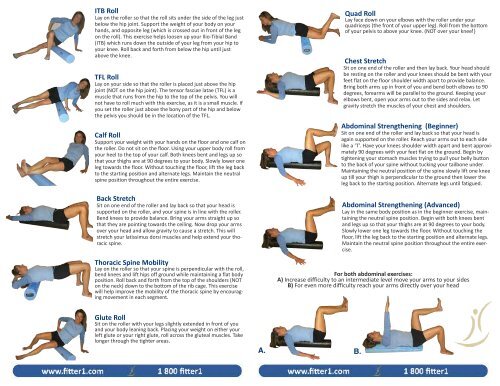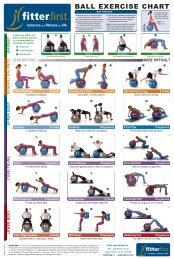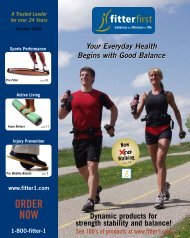Foam Roller Exercise Chart
Foam Roller Exercise Chart
Foam Roller Exercise Chart
Create successful ePaper yourself
Turn your PDF publications into a flip-book with our unique Google optimized e-Paper software.
ITB Roll<br />
Lay on the roller so that the roll sits under the side of the leg just<br />
below the hip joint. Support the weight of your body on your<br />
hands, and opposite leg (which is crossed out in front of the leg<br />
on the roll). This exercise helps loosen up your Ilio-Tibial Band<br />
(ITB) which runs down the outside of your leg from your hip to<br />
your knee. Roll back and forth from below the hip until just<br />
above the knee.<br />
TFL Roll<br />
Lay on your side so that the roller is placed just above the hip<br />
joint (NOT on the hip joint). The tensor fasciae latae (TFL) is a<br />
muscle that runs from the hip to the top of the pelvis. You will<br />
not have to roll much with this exercise, as it is a small muscle. If<br />
you set the roller just above the bony part of the hip and below<br />
the pelvis you should be in the location of the TFL.<br />
Calf Roll<br />
Support your weight with your hands on the floor and one calf on<br />
the roller. Do not sit on the floor. Using your upper body roll from<br />
your heel to the top of your calf. Both knees bent and legs up so<br />
that your thighs are at 90 degrees to your body. Slowly lower one<br />
leg towards the floor. Without touching the floor, lift the leg back<br />
to the starting position and alternate legs. Maintain the neutral<br />
spine position throughout the entire exercise.<br />
Back Stretch<br />
Sit on one end of the roller and lay back so that your head is<br />
supported on the roller, and your spine is in line with the roller.<br />
Bend knees to provide balance. Bring your arms straight up so<br />
that they are pointing towards the ceiling. Now drop your arms<br />
over your head and allow gravity to cause a stretch. This will<br />
stretch your latissimus dorsi muscles and help extend your thoracic<br />
spine.<br />
Thoracic Spine Mobility<br />
Lay on the roller so that your spine is perpendicular with the roll,<br />
bend knees and lift hips off ground while maintaining a flat body<br />
position. Roll back and forth from the top of the shoulders (NOT<br />
on the neck) down to the bottom of the rib cage. This exercise<br />
will help improve the mobility of the thoracic spine by encouraging<br />
movement in each segment.<br />
Glute Roll<br />
Sit on the roller with your legs slightly extended in front of you<br />
and your body leaning back. Placing your weight on either your<br />
left glute or your right glute, roll across the gluteal muscles. Take<br />
longer through the tighter areas.<br />
Quad Roll<br />
Lay face down on your elbows with the roller under your<br />
quadriceps (the front of your upper leg). Roll from the bottom<br />
of your pelvis to above your knee. (NOT over your knee!)<br />
Chest Stretch<br />
Sit on one end of the roller and then lay back. Your head should<br />
be resting on the roller and your knees should be bent with your<br />
feet flat on the floor shoulder width apart to provide balance.<br />
Bring both arms up in front of you and bend both elbows to 90<br />
degrees, forearms will be parallel to the ground. Keeping your<br />
elbows bent, open your arms out to the sides and relax. Let<br />
gravity stretch the muscles of your chest and shoulders.<br />
Abdominal Strengthening (Beginner)<br />
Sit on one end of the roller and lay back so that your head is<br />
again supported on the roller. Reach your arms out to each side<br />
like a ‘T’. Have your knees shoulder width apart and bent approximately<br />
90 degrees with your feet flat on the ground. Begin by<br />
tightening your stomach muscles trying to pull your belly button<br />
to the back of your spine without tucking your tailbone under.<br />
Maintaining the neutral position of the spine slowly lift one knee<br />
up till your thigh is perpendicular to the ground then lower the<br />
leg back to the starting position. Alternate legs until fatigued.<br />
Abdominal Strengthening (Advanced)<br />
Lay in the same body position as in the beginner exercise, maintaining<br />
the neutral spine position. Begin with both knees bent<br />
and legs up so that your thighs are at 90 degrees to your body.<br />
Slowly lower one leg towards the floor. Without touching the<br />
floor, lift the leg back to the starting position and alternate legs.<br />
Maintain the neutral spine position throughout the entire exercise.<br />
For both abdominal exercises:<br />
A) Increase difficulty to an intermediate level move your arms to your sides<br />
B) For even more difficulty reach your arms directly over your head<br />
A. B.








